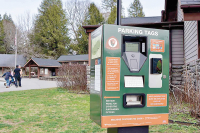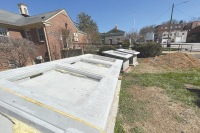Controversial billboard clearcutting gets fuller viewing
By Paul Clark • Contributor
Implementation of a new state law that increases the amount of land that can be clear-cut in front of highway billboards will get final tweaking and a public audience this month.
The N.C. Department of Transportation will take public input before finalizing rules for how the controversial tree-cutting will be performed. A law clearing the way for more clear-cutting passed the General Assmebly in July 2011. The law itself is not up for discussion, said Jamille Robbins, a DOT transportation engineer associated with the public hearing. But, commenters can have a say in the permanent rules that will be used to put the law in effect.
The new law will undoubtedly have visual impacts on mountain highways. Billboard companies have already applied for permission to clear trees in front of 10 billboards on a 20-mile stretch of Interstate 40 in Haywood County, according to the DOT.
It’s important that people speak up, said Ryke Longest, who runs the Duke Environmental Law and Policy Clinic. On behalf of the nonprofit environmental corporation Scenic NC, he sought an injunction against the temporary rules until people had more chance to comment on them.
“We’ve already seen an increase in cuts along billboard areas in Western North Carolina,” Longest said. The billboard industry will push for less stringent rules on how the clearing can be carried out, Longest said.
Related Items
The new law affects less than 1 percent of trees along the state’s highways and interstates, countered Paul Hickman, president of the N.C. Outdoor Advertising Association. Even with the expanded cut zones, the law doesn’t allow billboard owners to create the “view zone” they had when they erected their signs more than 30 years ago, he said.
The law, introduced by Sen. Harry Brown, R-Jacksonville, expands the “vegetation removal zone” that can be trimmed in front of billboards to 380 feet in rural areas and to 340 feet in towns and cities. It had been 200 feet.
As you might expect from an issue that has its own Facebook page, environmental organizations and the outdoor advertisement industry have been at odds over the legislation, which affects the trees, bushes and scrub in front of some 8,000 billboards in North Carolina.
The law was opposed by many entities, including municipalities such as Asheville that fear losing control over billboards, an issue the state had left largely to local governments. Environmental groups objected on a variety of issues, notably the loss of mature trees, the threat to growth in front of newly erected outdoor advertising and what they contended would be visual pollution of the state’s roads and byways.
Outdoor advertisers countered that the loss of vegetation would be minimal and will actually make the state’s highways and interstates safer.
The DOT has been administering the law under temporary rules it put in place shortly after the law was passed. State law requires the imposition of permanent rules, and that’s what DOT will formulate, based in part on public hearings held this month in Asheville, Raleigh and Winterville.
Soon after the outdoor advertising legislation was passed, DOT drafted temporary rules and let the public comment on them at a November hearing in Raleigh. The rules were adopted in January by DOT’s review committee but only after DOT made some changes — changes that Robbins called “slight” and Longest called “significant.”
In its request asking for the injunction, Longest and Scenic NC said DOT “materially changed the text of the temporary rules” between the lone public hearing and their presentation to the review committee. That deprived the public from commenting on the changes prior to adoption, the plaintiffs said.
Hickman, who manages Fairway Outdoor Advertising’s operations in the eastern part of the state, said he was in every legislative meeting regarding the bill. He said the changes that DOT made to the temporary rules that the review committee adopted more truly reflect what legislators wanted when they passed the law.
A judge dismissed Scenic NC’s complaint, saying that it had been a part of the rule-making process and had opportunity to voice its objections then.
One provision of the permanent rules allows DOT to deny a permit to remove vegetation if the trees and growth are protected by a conservation easement or by state or federal law. Longest and other environmentalists like that, but they don’t like another provision that allows owners to clear vegetation despite local ordinances that may protect it.
Cities and counties often protect growth along stream and river embankments because the vegetation prevents flooding by slowing water and holding banks in place. But under the proposed permanent rules, that vegetation can be cleared if there is no state or federal law protecting it, Longest said.
“The question is, does that law trump local ordinances? Scenic NC says no, the outdoor advertisement industry says yes, and DOT agrees with the industry,” said Longest. “We believe that local ordinances should have equal status with state and federal laws” prohibiting vegetation clearing.
The N.C. Outdoor Advertising Association isn’t asking for a whole lot, compared with what they had, Hickman said. Back in the 1970s and 1980s, when most billboards were built, outdoor advertisers could erect them only where they had a naturally occurring 500-foot view zone, he said. No vegetation could be cut to achieve the 500 feet — it had to be there already.
If a billboard had two sides, the view zone had to be 1,000 feet. As the vegetation grew under the signs, legislation was passed that allowed owners to clear 125 feet per side, then 250 feet. This new law still falls short of the 500 feet under which most signs were erected, Hickman said.
Clearing view zones within the new parameters will have the unintended, added advantage of making the highways safer for motorists, said Hickman. He said 277 people die every year from hitting trees in the right-of-way.
Want to weigh in?
A public hearing on the rules for clearing trees in front of highway billboards will be held at 7 p.m. Aug. 13 at the city of Asheville Public Works Building, 161 S. Charlotte St., Room A-109. Can’t attend? Send comments by Sept. 14 by going to www.ncdot.gov/about/regulations/rules/ProposedRules3.html. Or call 919.707.2800 and asking for the APA Coordinator.









